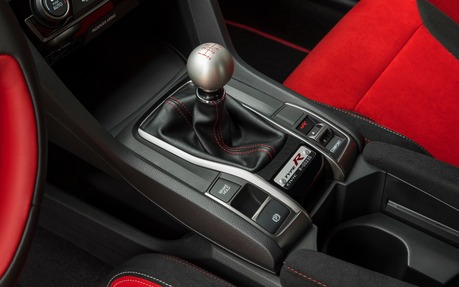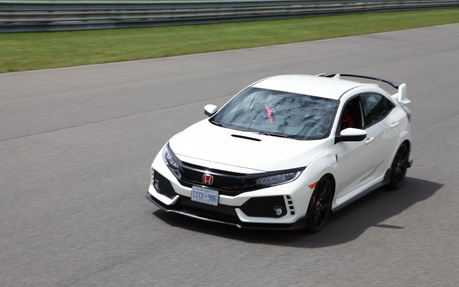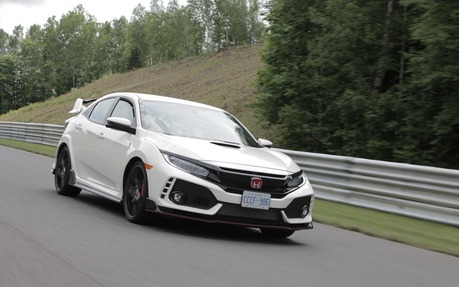2017 Honda Civic Type R: Full Throttle at Circuit Mont Tremblant
MONT TREMBLANT, Quebec – Both icon and—until now—forbidden fruit, it’s no surprise that the Civic Type R is one of the most eagerly anticipated cars of the year. The 2017 Honda Civic Type R is the brand’s fastest and most powerful car, and it’s finally rolling into Canadian dealerships. It comes in either Championship White or Crystal Black Pearl and starts at $40,890.
My first encounter with the Civic Type R was in a dream setting, Circuit Mont Tremblant. Honda had retained the services of instructors to “guide” journalists as we acquainted ourselves with the car and I was pleasantly surprised to see Philippe Létourneau in the passenger seat next to me. As I had personally contributed to Philippe’s education back in the day at the Jim Russell Racing Driver School, the role reversal struck me as fun. All I had to do was hop in, select R mode on the centre console and push the car to the limit.

The 2.0-litre four-cylinder engine is fed by a turbocharged that delivers 23.2 psi of pressure. With 306 horsepower at 6500 rpm and 295 lb.-ft. of torque available between 2500 and 4500 rpm, the Type R launched itself into Turn One right out of the pits with impressive poise. Thrust isn’t relentless, but it’s quite sustained, especially in first, second and third gears thanks to the VTEC valve timing system and turbocharger.
The only available transmission is a six-speed manual whose shifter is remarkably precise. The clutch is as easy to engage as that of a conventional Civic. Once the Type R attacked the Devil’s Turn and then The Esses, it was clear that this would be no ordinary track test drive.
Although the Type R is front-wheel driven, there’s no noticeable torque effect in the steering wheel in flat-out acceleration, which is truly exceptional. This is owing to its dual-axis front suspension—the first being linked to the suspension itself and the second being linked to the steering. This unique design explains why the circuit’s corners had no effect whatsoever on the delivery of the power when exiting turns, helping guide the car on the ideal trajectory with millimetre precision.
Exceptional chassis dynamics
When coming out of The Esses, I shifted into fourth and fifth gear for Turn Six, then braked and downshifted for Turn Seven, which we took in fourth gear. This blind turn’s braking zone includes a slight bump before the entry point and another just before the apex, where the incline of the track becomes negative until the exit point of the turn. The Type R laughed in the face of all of that and headed toward Turn Eight, which we took in third.
As we exited this turn, which includes two apexes, Philippe recommended shifting into fourth and fifth before reaching the maximum rev limit. The result was beneficial, with the Type R gaining several kilometres/hour more on the long back straight. The car really stuck to the pavement in Turn Ten and the transition from the left side to the right side was smooth as silk for The Gulch and the climb toward the Bridge Turn. Next, it’s the Kink, Namerow and Paddock Bend before crossing the finish line and beginning another lap.

What did I learn from the Type R test drive at Circuit Mont Tremblant? This car has an exceptional chassis. It’s so good, in fact, that it could easily handle an additional 30 or 40 horsepower without needing too many modifications. And the car’s dynamics are absolutely fantastic. The reactions are always predictable and it’s a real pleasure to see how comfortable the Type R is on this very demanding—and unforgiving—circuit.
There are just two drawbacks. Braking is efficient with 13.8-inch ventilated discs and Brembo callipers in front, but the pedal travel is a little long. Also, the engine doesn’t pull as much in fourth and fifth gears as in first through third and the engine isn’t very loud: more decibels means more thrills. That’s it for the weaknesses. They are few and far between.
In closing, remember that this test drive was limited to the track, so I may have missed details about its handling or comfort on regular thoroughfares; that will have to be a topic for another day. On the circuit, however, the Type R delivered the goods with remarkable poise and exceptional dynamics.
| Test drive report | |
| Test model | 2017 Honda Civic |
|---|---|
| Trim level | Type R |
| Price range | N/A |
| Price as tested | 40 890 $ |
| Warranty (basic) | 3 years/60,000 km |
| Warranty (powertrain) | 5 years/100,000 km |
| Fuel economy (city/highway/observed) | 10,6 / 8,3 / N/A L/100km |
| Options | N/A |
| Competitive models | Volkswagen Jetta, Volkswagen Beetle, Toyota Corolla, Subaru Impreza, Nissan Sentra, Mitsubishi Lancer, Mazda Mazda3, Kia Forte, Hyundai Elantra, Ford Focus, Dodge Dart, Chevrolet Cruze, Buick Verano |
| Strong points |
|
| Weak points |
|
| Editor's rating | |
| Fuel economy | Still reasonable considering the performance potential. |
| Comfort | Very good on the track, but what will it be like on public roads? |
| Performance | The engine is very efficient and propels the car well in first, second and third gears, but less so in fourth and fifth. |
| Infotainment | I didn’t use it at all (test drive on track only), but it has Apple CarPlay and Android Auto. There’s no volume control knob on the dash as with the other Civics. |
| Driving | Dynamics are top-notch. It’s the best front-wheel drive that ever driven on a track. There’s no torque effect and it’s very stable. |
| Overall | Wow, what a car! |
